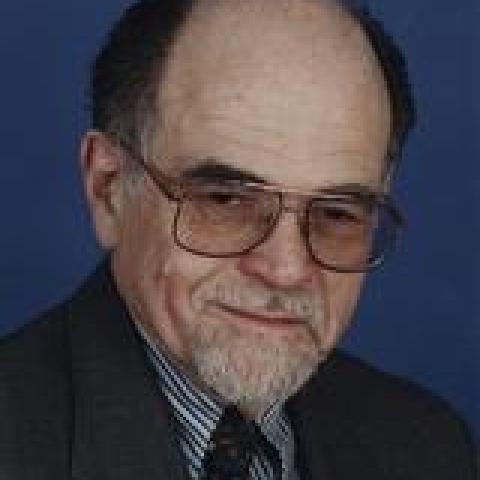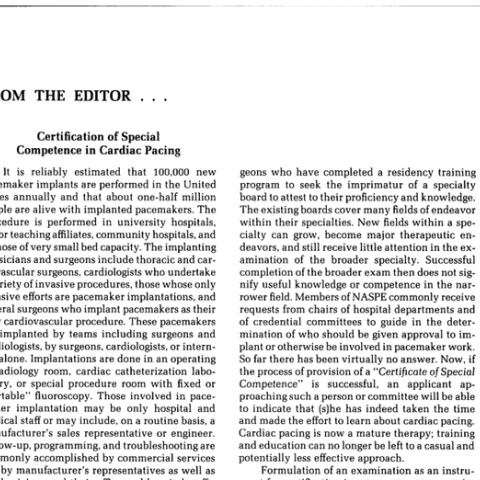History
IBHRE certification exams were conceptualized in 1984. On October 11, 1984, Past Presidents of NASPE met concerning the design of a certification exam, and they agreed that this initiative should be pursued. Established in 1985 as NASPExAM, IBHRE is a self-governing, credentialing organization that provides competency certification in the fields of cardiac rhythm device therapy and cardiac electrophysiology for physicians and allied professionals.
IBHRE Timeline:
| 1980s | 1990s | 2000s | 2010s | 2020s |
1980s:
- 1984
- First President and founder of NASPExAM - now the International Board of Heart Rhythm Examiners, Dr. Seymour Furman, led the initiative to certify competence in cardiac pacing
- The National Board of Medical Examiners is approved to administer exam
- 1985
- NASPExAM is established
- Cardiac Pacing Test Writing Committee is founded; 14 physician members with inclusion of a lead allied professional Co-Chair, Marleen Irwin
- 1986
- Articles of Organization for NASPExAM were signed; the principal office of the corporation was in Massachusetts
- First examinations of Special Competency in Cardiac Pacing and Cardioversion Defibrillation for the Physician are administered in San Francisco, Chicago and New York
- 1989
- First Examinations for Special Competency in Cardiac Pacing and Cardioversion Defibrillation for the Allied Professional are administered in Los Angeles, Chicago, New York, and London
1990s:
- 1996
- Role delineation study is conducted to update essential competencies for allied professionals to reflect changes in current practice and cardiac electrophysiology test writing committee founded with a lead allied professional Co-Chair, Christine Chiu-Man
- Cardiac Electrophysiology Test Writing Committee is founded
- 1997
- First Examinations for Special Competency in Cardiac Electrophysiology for the Allied Professional are administered in New Orleans and New York
- 1998
- Dr. David Steinhaus becomes second President of NASPExAM
2000s:
- 2004
- NASPExAM moves to a Washington, D.C. office
- 2005
- Dr. Charles J. Love becomes third President of NASPExAM
- Physician device exam is recognized as a competency requirement for completion of the Heart Rhythm Society’s alternate training pathway for non-electrophysiologists
- NASPExAM adopts new bylaws, a new strategic plan, and expands the Board of Directors to include international members from Japan, London, and Canada
- 2006
- NASPExAM becomes the International Board of Heart Rhythm Examiners
- New IBHRE website is launched and first web-based registration system is introduced
- Job task analyses is conducted to initiate change from competency to certification, to identify core tasks in heart rhythm practice, and to standardize a global knowledge-base of heart rhythm professionals
- Market research and promotional strategy is conducted around the value of IBHRE certification
- 2007
- Examinations are re-named and structured to align with new certification program
- Certification Examination for Competency in Cardiac Rhythm Device Therapy for the Physician
- Certification Examination for Competency in Cardiac Rhythm Device Therapy for the Allied Professional
- Certification Examination for Competency in Cardiac Electrophysiology for the Allied Professional
- New certification credentials announced:
- Certified Cardiac Device Specialist (Physician)
- Certified Cardiac Device Specialist (Allied Professional)
- Certified EP Specialist (Allied Professional)
- Strategic partnership is formed with the Japanese Heart Rhythm Society and first IBHRE Japanese Test Translation Committee is established
- New organizational structure, policies, and procedures to support the administration of the new IBHRE program and preparation for certification personnel accreditation from the American National Standards Institute (ANSI) is established
- Examinations are re-named and structured to align with new certification program
- 2008
- First introduction of computer-based testing and world-wide administration of certification examinations
- First tailored foreign-language certification exam is administered in Japan to 644 cardiac pacing allied professionals
- IBHRE establishes registered trademarks for the IBHRE name and certification marks
- 2009
- IBHRE submits an application to ANSI for accreditation under ISO Standard 17024 for Personnel Certification Programs
- Physician Electrophysiology Test Writing Committee is founded to develop international-based adult and pediatric EP exams for physicians
- New Recertification Policy is established to require maintenance of certification every 5 years and recertification every 10 years
- First IBHRE Review and Appeals Committee is established
2010s
- 2010
- IBHRE receives American National Standard Institute Accreditation
- 2011
- IBHRE officially announces the Examination for Special Competency in Cardiac Electrophysiology for the Physician
- 2013
- New Leadership Recruitment Campaign is conducted
- IBHRE forms new Content Experts Committee and an Ambassador Group
- New website and Career Center is launched
- IBHRE Endorsement Program is created
- 2014
- Maintenance of Certification Online Application is launched
- IBHRE celebrates its first IBHRE Day on February 11, 2014
- 2015
- IBHRE launches scholarship program for allied professionals
- 2016
- ANSI reaccreditation of CCDS and CEPS certification programs
- ANSI accreditation of CEPS-A and CEPS-P certification programs
- Maintenance of Certification (MoC) becomes Verification of Continuing Education (VCE)
- IBHRE presents the first Ambassador Award and Vanguard Award
- 2018
- IBHRE launches Cardiac Device Education and Self-Assessment Course, an online course based upon the CCDS exam content outline
2020s
- 2021
- IBHRE launches Cardiac Device Remote Monitoring Specialist (CDRMS)
- 2022
- IBHRE launches IBHRE-C3, a continuous competency program based upon longitudinal assessment for maintaining certification
- 2023
- IBHRE launches volume 2 of the Cardiac Device Education and Self-Assessment Course
Historic Pacemakers
Click here to view various devices and pacemakers.

Seymour Furman was the first to recognize the usefulness of pacing the heart endocardially, which ultimately led to the development of an entirely new discipline of clinical cardiac electrophysiology.

Reprinted from PACE journal, Vol. 9, No. 1 (January–February, 1986), p 1.

